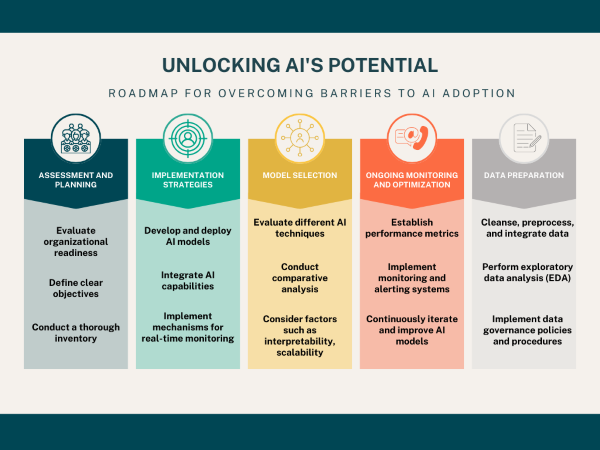Unlocking AI's Potential: Roadmap for overcoming barriers to AI adoption
Many industry reports highlight the growing reliance on artificial intelligence (AI) across various sectors. From predictive analytics to personalized recommendations, AI is reshaping the way businesses operate. For example, The AI Index 2023 report by Stanford University, highlight the growing reliance on artificial intelligence (AI) across various sectors.
The report says, “Although 2022 was the first year in a decade where private AI investment decreased, AI is still a topic of great interest to policymakers, industry leaders, researchers, and the public. Policymakers are talking about AI more than ever before. Industry leaders that have integrated AI into their businesses are seeing tangible cost and revenue benefits. The number of AI publications and collaborations continues to increase. And the public is forming sharper opinions about AI and which elements they like or dislike.”
However, amidst this transformation, there remains a critical challenge: the hesitancy to fully embrace AI's potential.
Here’s a roadmap on how your organization can overcome the barrier of AI adoption and jump the bandwagon sooner than later.

Assessment and Planning
- Evaluate organizational readiness for AI adoption, including assessing data infrastructure, technical capabilities, and cultural readiness.
- Define clear objectives and goals for AI implementation, aligning them with overall business strategy and priorities.
- Conduct a thorough inventory of available data sources and assess data quality, completeness, and relevance for AI applications.
Data Preparation
- Cleanse, preprocess, and integrate data from disparate sources to create a unified dataset for AI modeling.
- Perform exploratory data analysis (EDA) to gain insights into the data characteristics, identify patterns, and uncover potential issues or anomalies.
- Implement data governance policies and procedures to ensure data quality, integrity, and security throughout the AI lifecycle.
Model Selection
- Evaluate different AI techniques and algorithms based on their suitability for the specific problem domain and data characteristics.
- Conduct comparative analysis and experimentation to identify the most effective models for achieving the desired outcomes.
- Consider factors such as interpretability, scalability, and computational efficiency when selecting AI models for production deployment.
Implementation Strategies
- Develop and deploy AI models using scalable and robust infrastructure, leveraging cloud computing resources and containerized environments.
- Integrate AI capabilities into existing business processes and workflows to maximize impact and minimize disruption.
- Implement mechanisms for real-time monitoring and feedback to continuously assess model performance and effectiveness in production settings.
Ongoing Monitoring and Optimization
- Establish performance metrics and key performance indicators (KPIs) to evaluate the effectiveness and impact of AI solutions.
- Implement monitoring and alerting systems to detect anomalies, drift, and degradation in model performance over time.
- Continuously iterate and improve AI models through techniques such as retraining, fine-tuning, and ensemble learning to adapt to evolving data patterns and business requirements.
Organizational Training and Change Management
- Provide training and education programs to upskill employees and stakeholders on AI concepts, technologies, and best practices.
- Foster a culture of experimentation, innovation, and continuous learning to embrace AI-driven decision-making and problem-solving.
- Develop change management strategies to address organizational resistance, mitigate risks, and ensure successful adoption and integration of AI solutions.
By following this roadmap, organizations can systematically overcome barriers to AI adoption and successfully implement AI solutions that drive business value and competitive advantage.
You've got the roadmap to AI success right in your hands. With these steps, any organization can smash through those barriers to AI adoption and start reaping the rewards. Ready to take your business to the next level? Dive into AI with confidence, and watch those competitive advantages stack up. Oh, and don't forget to join us on our podcast for more insider tips, and hit that subscribe button on our YouTube channel, Tech Beyond Boundaries. Let's rock the tech world together! Until next time, keep innovating!




